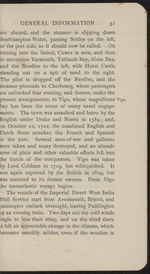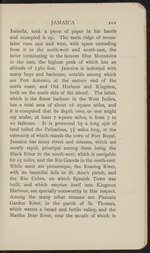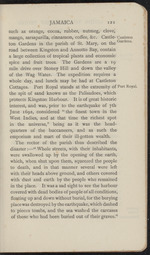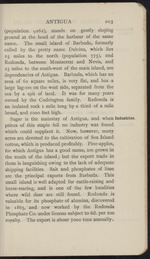| 1 |
 |
“...GENERAL INFORMATION
3i
are aboard, and the steamer is slipping down
Southampton Water, passing Netley on the left,
or the port side, as it should now be called. On
turning into the Solent, Cowes is seen, and then
in succession Yarmouth, Totlands Bay, Alum Bay,
and the Needles to the left, with Hurst Castle
standing out on a spit of sand to the right.
The pilot is dropped off the Needles, and the
steamer proceeds to Cherbourg, where passengers
are embarked that evening, and thence, under the
present arrangements, to Vigo, whose magnificent Vigo,
bay has been the scene of many naval engage-
ments. The town was assaulted and burnt by the
English under Drake and Norris in 1589; and,
on October 22, 1702, the combined English and
Dutch fleets attacked the French and Spanish
in the port. Several men-of-war and galleons
were taken and many destroyed, and an abund-
ance of plate and other valuable effects fell into
the hands of the conquerors. Vigo was taken
by Lord Cobham in 1719, but relinquished...”
|
|
| 2 |
 |
“...east, the highest peak of which has an
altitude of 7360 feet Jamaica is indented with
many bays and harbours, notable among which
are Port Antonio, at the eastern end of the
north coast, and Old Harbour and Kingston,
both on the south side of the island. The latter,
which is the finest harbour in the West Indies,
has a total area of about 16 square miles, and
it is computed that its depth over, or one might
say under, at least 7 square miles, is from 7 to
10 fathoms. It is protected by a long spit of
land called the Palisadoes, 7J miles long, at the
extremity of which stands the town of Port Royal.
Jamaica has many rivers and streams, which are
mostly rapid, principal among them being the
Black River in the south-west, which is navigable
for 25 miles, and the Rio Grande in the north-east.
While most are picturesque, the Roaring River,
with its beautiful falls in St. Ann’s parish, and
the Rio Cobre, on which Spanish Town was
built, and which empties itself into Kingston
Harbour, are specially...”
|
|
| 3 |
 |
“...as orange, cocoa, rubber, nutmeg, clove,
mango, sarsaparilla, cinnamon, coffee, &c. Castle- Castleton
ton Gardens in the parish of St Mary, on the Gardens-
road between Kingston and Annotto Bay, contain
a large collection of tropical plants and economic
spice and fruit trees. The Gardens are a 19
mile drive over Stoney Hill and down the valley
of the Wag Water. The expedition requires a
whole day, and lunch may be had at Castleton
Cottages. Port Royal stands at the extremity of Port Royal,
the spit of sand known as the Palisadoes, which
protects Kingston Harbour. It is of great historic
interest, and was, prior to the earthquake of 7th
June 1692, considered “the finest town in the
West Indies, and at that time the richest spot
in the universe,” being as it was the head-
quarters of the buccaneers, and as such the
emporium and mart of their ill-gotten wealth.
The rector of the parish thus described the
disaster“ Whole streets, with their inhabitants,
were swallowed up by the opening of the...”
|
|
| 4 |
 |
“...ANTIGUA
203
(population 9262), stands on gently sloping
ground at the head of the harbour of the same
name. The small island of Barbuda, formerly
called by the pretty name Dulcina, which lies
25 miles to the north (population 775), and
Redonda, between Montserrat and Nevis, and
25 miles to the south-west of the main island, are
dependencies of Antigua. Barbuda, which has an
area of 62 square miles, is very flat, and has a
large lagoon on the west side, separated from the
sea by a spit of land. It was for many years
owned by the Codrington family. Redonda is
an isolated rock 1 mile long by a third of a mile
broad, and 1000 feet high.
Sugar is the mainstay of Antigua, and when Industries,
prices of this staple fell no industry was found
which could supplant it. Now, however, many
acres are devoted to the cultivation of Sea Island
cotton, which is produced profitably. Pine-apples,
for which Antigua has a good name, are grown in
the south of the island; but the export trade in
them is languishing...”
|
|
